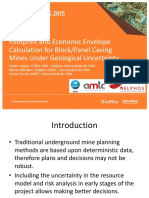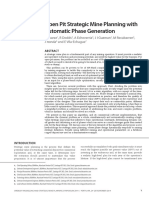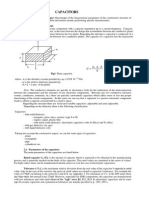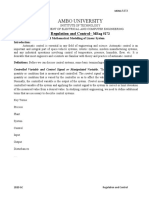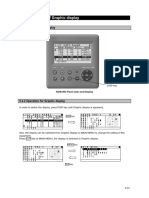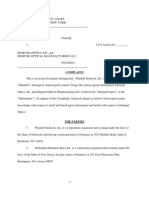Estimation of Incremental Haulage Costs by Mining Historical Data and Their Influence in The Final Pit Definition PDF
Estimation of Incremental Haulage Costs by Mining Historical Data and Their Influence in The Final Pit Definition PDF
Uploaded by
Galuizu001Copyright:
Available Formats
Estimation of Incremental Haulage Costs by Mining Historical Data and Their Influence in The Final Pit Definition PDF
Estimation of Incremental Haulage Costs by Mining Historical Data and Their Influence in The Final Pit Definition PDF
Uploaded by
Galuizu001Original Title
Copyright
Available Formats
Share this document
Did you find this document useful?
Is this content inappropriate?
Copyright:
Available Formats
Estimation of Incremental Haulage Costs by Mining Historical Data and Their Influence in The Final Pit Definition PDF
Estimation of Incremental Haulage Costs by Mining Historical Data and Their Influence in The Final Pit Definition PDF
Uploaded by
Galuizu001Copyright:
Available Formats
T E C H N I C A L P A P E R S
Estimation of incremental haulage costs by
mining historical data and their influence in
the final pit limit definition
Introduction R. BENITO AND S.D. DESSUREAULT typical input economic parameters.
Diverse economic and physi- Examples of physical parameters
cal parameters are considered for R. Benito and S.D. Dessureault, members SME, are gradu- are the ore grade distribution, geo-
openpit optimization. Mining costs, ate research assistant and associate professor, respectively, technical constraints and metallur-
included in the block-valuing pro- with the Department of Mining and Geological Engineering, gical recoveries.
cess, are defined by the main ac- University of Arizona, Tucson, AZ. Paper number TP-07-030. Block models are widely used by
tivities involved: drilling, blasting, Original manuscript submitted August 2007. Revised manu- specialized mining software to assist
loading, hauling and ancillary oper- script accepted for publication June 2008. Discussion of this in the final pit outlining process, by
ations (pit roads and dumps). From peer-reviewed and approved paper is invited and must be storing the economic and physical
the main activities mentioned, haul- submitted to SME Publications Dept. prior to Jan. 31, 2009. parameters in each block. Block val-
ing is considered the most resource-consuming activity ue or profit per block is calculated
in a typical openpit truck-shovel operation (Blackwell, by subtracting the revenue generated from selling the
1999). The aim of this research was the determination of recoverable contained metal minus the costs incurred to
historical haulage costs and their variations by location. produce it. Variable costs (mining, processing, marketing
For this purpose, the fundamentals of the two-stage and restoration costs) and fixed costs (e.g., overheads)
cost-tracing procedure (Cooper, 1987a) were applied are usually considered for block valuing. After all blocks
to trace incurred haul costs by bench. This approach conforming a three-dimensional model are valued, the
requires the definition of a measure of the quantity final step is the application of a numerical method for
of resources consumed during its second stage called pit outlining. Lerchs-Grossmann algorithm is a popular
cost driver. Tracing costs by location from real data is a method to determine the size and shape of the ultimate
challenging task due to the dynamic nature of haulage pit. This final shape maximizes the value of the mine
activity, which is usually controlled by truck dispatch subject to slope constraints (Whittle, 1996).
systems. These systems assign trucks arbitrarily to load- Final pit limit definition continues, even during the
ing points. Their objective is the maximization of truck operation stage, in order to evaluate potential mine
utilization and reduction of waiting and delay times. expansions. An updated version of the life-of-mine plan
In contrast, haulage costs are usually stored as general (LOM), including the final pit limit definition, is usually
transactions, not detailed by location, due mainly to the prepared once a year for budgeting purposes. Various
structure of cost accounting systems. input parameters for openpit outlining may be updated
based on historical data. These input parameters may
Final pit limits reflect the actual performance achieved in terms of pro-
Mine plans, in particular long range mine plans, are duction and incurred costs. Variable haulage costs by
usually developed within a final pit outline. The process bench are economic inputs that can be updated using
requires the definition of various physical and economic historical data. Detailed and extensive information re-
parameters. Commodity prices and anticipated costs lated to truck haulage performance and incurred costs is
(mining, processing, selling, rehabilitation costs) are mostly available in operating mines and stored in large
operational database systems such as truck dispatch
systems and financial transaction systems. This vast
Abstract amount of information can be integrated, processed and
This paper describes the application of modern data-anal- analyzed by using relatively new information technol-
ysis tools, such as data mining, to determine a representa- ogy, namely, data warehouse and data mining.
tive cost driver for haulage activity. This cost driver was
subsequently used to trace incurred haul costs by bench Data warehouse and data mining
for openpit optimization. For this purpose, large amount of Enterprises now maintain two databases, one con-
previously unused cost and production data from an open taining operational data (to assist the day-to-day opera-
pit mine was extracted, loaded, transformed and integrated tion) and one called the data warehouse (DW), which
into a data warehouse. Predictive modeling was performed contains decision support data (Date, 2004). Data ware-
using Microsoft Decision Trees algorithm to compute ex- houses are databases that are used to support man-
pected unit haul costs by bench for future mine expansions. agement decisions. They are populated and updated
Finally, a sensitivity analysis was carried out to determine on a periodic basis from operational databases called
the effect of two cost drivers (if any) for incremental haul online transaction processing databases (OLTP). For a
costs in the final pit outline process. mining operation, a data warehouse may be populated
44 OCTOBER 2008 MINING ENGINEERING
with historical production data and FIGURE 1
incurred operating costs. Figure 1 is
Attributes stored in a production data table.
a graphical representation of mine
production data and their attributes
stored in a transactional table for an
openpit operation. This figure shows
the detailed distribution of loading
and dumping points, captured and
stored using modern global position-
ing systems (GPS). The centroid of
the bench is also shown, which is
usually considered as a single load-
ing point for the estimation of truck
productivity during the preparation
of the LOM plan.
Data mining is a data-analysis
process that identifies trends and patterns of a busi- which includes spot, load, haul, turn, dump, empty re-
ness process (Chao, 2006). Data mining, also known as turn, wait and delay times (Hays, 1990). Usually, for
knowledge discovery, is a rapidly developing trend in mine planning purposes, the total cycle time is calcu-
data management. Data mining has become a popular lated using truck simulation software. Projected haul
tool for managers, analysts and experts in commercial profiles and truck rimpull/retarding curves are used
and government organizations. The development of to calculate expected total cycle times by bench and
hardware and software technology allowed for the evo- destination. For simplification, it is assumed that the
lution of data analysis in large databases. Retrospective haul and return segments are the same. However, with
and static data delivery was only possible in the 1960s, the use continuous use of dispatch systems, trucks are
while presently, data mining techniques allows obtain- often assigned dynamically to maximize their utiliza-
ing prospective and proactive information. tion. This section describes the process to define a cost
Classification, clustering, association, regression, driver that reflects adequately the resource consump-
forecasting, sequence and deviation analysis are typical tion (fuel, tires, parts, etc.) for haulage activity using
examples of data mining tasks. Decision trees and neu- historical data. Specifically, the cost driver should reflect
ral networks are two popular data mining techniques variances in haulage costs due to mining location. For
available in Microsoft SQL 2005. These techniques are this purpose, detailed information from a truck dispatch
mainly derived from statistics, machine learning and system and a financial transaction system was provided
database (Tang, 2005). from an open pit mine and stored in a data warehouse.
Data collection, data cleaning and transformation Data cleaning and data filtering were the initial tasks
are required steps and must be achieved prior to the performed using Microsoft SQL 2005 Server Manage-
application of a particular data mining technique. Truck ment Studio. These tasks were accomplished by creating
haulage performance trends (e.g., lower productivities queries or views and integrating transactional tables.
due to increased haul distance) and the variables influ- Table 1 displays a summary of the main transactional
encing such trends can be analyzed through data mining. tables. The data implied two years of production and
Additionally, different truck performance measures may cost transactions.
be defined and analyzed to determine the most repre- For integration purposes, the data were aggregated
sentative for haulage activity. This measure may then on a monthly basis to balance the level of detail (granu-
be used as a cost driver to trace haulage costs by bench, larity) of production and cost tables. The steps men-
applying the fundamentals of the two-stage cost tracing tioned above are not detailed in this paper due to their
approach (Cooper, 1987b). The next section applies data extensive nature. Considering the available data, the
mining tools available in Microsoft SQL 2005 to define a following haulage performance indicators were consid-
representative cost driver for mine haulage activity. ered as potential cost drivers (predictable attributes):
Truck haulage performance analysis • total cycle time (cycletime),
Truck performance is usually associated to the cal- • haul time (haultime),
culation of incremental haulage costs. Davey (1979) • haul time plus return empty (haulreturn) and
describes an approach to estimate variable • haul distance (hauldist).
haulage costs by combining truck hourly Table 1
costs and truck performance (in tons per
operating hour), which is influenced by the Production and cost transactional tables.
size, equipment type and the haulage pro- Table name Type Columns Rows
files (length and lift). Unit costs are then
calculated by dividing the truck hourly lh_load_base Production 103 8,033,230
cost by the resulting truck productivity. lh_dump_base Production 41 5,417,215
Truck performance is typically expressed lh_location_base Production 10 2,483,645
in terms of hourly production rate (tons lh_equip_list_base Production 16 2,746,466
per hour), and it is calculated considering mdm_costs_base_updated Cost 64 34,441,192
truck payload and truck total cycle time,
MINING ENGINEERING OCTOBER 2008 45
FIGURE 2 the level of correlation between input
and predictable attributes. Each oval
Dependency network for truck performance indicators.
or node in the network represents an
attribute (input or predictable), and
the arrows represent the relationship
between two nodes. The direction of
the arrow points from the input and
to the predictable attribute. Accord-
ing to the DN of Fig. 2, “haultime”
has the strongest relationship (or
most correlated) with the input attri-
butes (bench, destination and lift).
Mining accuracy charts are tools
used to evaluate the quality and pre-
cision of a data mining model. Lift
charts, used for continuous variables,
are scatter plots that compare actual
versus predicted values from a mod-
el. An ideal model should group the
points on a 45° angle. Figure 3 shows
a lift chart for “cycletime” attribute,
and the corresponding score value
achieved. Higher score values stand
For this analysis, total cycle time excludes wait and for better accuracy in a model. The overall score showed
delay times in the truck cycle to determine the effec- in lift charts for continuous attributes represent the geo-
tive cycle time (spot, load, haul, turn, dump and empty metric mean of the individual scores for the points con-
return times). Microsoft Business Intelligence Devel- forming the scatter plot. The score of a particular point
opment Studio was used for the data mining analysis. in a scatter plot is given by
Considering the objective of defining a cost driver to
P[b( m ) | (a, m )] (1)
trace haulage costs by location, the following variables score [ a, b( m )] =
were considered as input attributes: P[ marginal _ mean | a ]
• bench. where
• destination. a is the actual attribute value and
• lift (Delta Z). b(m) is the predicted value using the model (m).
Chen (2001) suggests dividing the data into three Equation (1) assumes a normal distribution to com-
subsets: training, testing and evaluation sets for predic- pute the probabilities for both predicted and actual
tive modeling. For this analysis, two data sets were ar- values. Table 2 summarizes the different scores achieved
ranged: a training set to build the model (e.g., to define for the predictable attributes (potential cost drivers), for
equations between input/predictable attributes) and both training and testing data sets. Additionally, Table 2
a testing set to evaluate its accuracy. A data mining includes the square of the correlation coefficient (R2)
technique called Decision Trees was chosen for model for the models. It can be noted clearly that “haultime”
construction. For the case of continuous variables, the achieved the highest score values compared to the other
decision tree algorithm uses linear regression to decide indicators in both data sets. Figure 4 shows the decision
where a decision tree splits. A regression formula is cre- tree for “haultime,” with a regression formula in each
ated in each node of the tree. A split occurs at a point node of the tree. For instance, a haul profile having the
of nonlinearity in the regression formula. Generally, crusher (CR) as destination with a bench elevation less
a regression formula contains one or more regressors than 2,564 has the following expression:
(input attributes). If no regressor is present in the for-
mula, the result tree contains a constant in each leaf Haul time = 8.808 + 0.024* (2)
node. (Delta Z - 122.071) – 0.024*(Bench – 2,541.929)
Eight destinations were considered for model
construction according to the material type as-
signed. Twenty benches, with elevations between
Table 2
2,510 and 2,770 m (8,230 to 9,090 ft) above sea Scores and R2 for training and testing data sets.
level, were as well considered as origin points. Training set Testing set
Figure 2 shows a dependency network, which is Attribute name Units Score R2 Score R2
used generally as an exploratory data analysis.
This tool is included in the Microsoft Decision “haultime” minutes 5.50 0.94 4.98 0.96
Tree approach. The DN displays the relation- “haulreturn” minutes 4.16 0.92 2.94 0.82
ships among attributes (input and predictable) “cycletime” minutes 2.88 0.84 2.39 0.77
from the decision tree model’s content and their “hauldist” meters 3.24 0.87 2.43 0.83
associated weights. The weights are related with
46 OCTOBER 2008 MINING ENGINEERING
The diamond bars depicted in the FIGURE 3
nodes of the tree represent the value
distribution of the given node. The Lift chart for “cycletime” attribute.
width of the diamond indicates the
level of accuracy of the node — the
thinner the better in precision.
Considering the results shown
by the DN in Fig. 2 and the scores
values in Table 2, haul time may be
used as a representative cost driver
for haulage activity. Data mining
also allows predictive modeling to
determine expected haulage costs
for future benches. This calculation
may then be used for block valuing
purposes, the initial step of the pit
outlining process. For this purpose,
it was necessary to create a new data
set, specifying only the input parame-
ters (bench, destination and lift). The
mining model prediction function
available in Business Intelligence al-
lows calculating expected haul time
values according to the input values. This expected val- incremental unit haulage cost curves for the two cost
ue, combined with the haulage costs by month and the drivers having the crusher as the final destination. Simi-
average truck payload provide the means to calculate lar shapes were also obtained for the other destina-
variable haulage costs by bench and destination. tions. The dotted lines represent expected unit costs
for future benches. The expected values are the output
Final pit limit analysis of the prediction function of the Microsoft Decision
The objective of this analysis was to assess the effect Trees model. The haul time curve indicates that unit
in the final pit limits outlining when using two differ- haul costs are lower compared to the cycle time curve
ent cost drivers to trace haulage costs by bench. Haul between 0 and -120 m (-400 ft) lift interval. Conversely,
time, the most correlated attribute, and cycle time, the as the lift “increases,” unit haul costs are higher for the
lowest scored attribute, were selected as cost drivers. haul time curve.
Tracing incurred costs by bench requires the calcula- Block value was carried out using a regular three-
tion of burden rates (Cooper, 1987b). These rates are dimensional block model representing a low-grade
computed dividing the total costs incurred (from a copper porphyry deposit, where heap leaching was the
cost center) by the total of units consumed (e.g., haul current beneficiation method. For simplification, only
hours). For the two cost drivers selected, the totals of two destinations were evaluated: crusher if leach ore
units consumed (TUC) are expressed in time units. For and dump if waste. However, it is possible to include
haul time, TUC is expressed as total truck haul hours; multiple destinations for diverse material types for a
while for cycle time TUC is the total truck cycle hours complex pit optimization (e.g., beneficiation processes
(effective hours). Full haulage costs include operating for various ore types, diverse types of waste). The fol-
and maintenance expenses. These values were cumu- lowing economic parameters were considered for block
lated over the range of the stored data. After dividing valuing:
the total haulage
costs by the TUC
for each driver, Table 3
the following bur- Pit optimization results.
den rates are ob-
tained: $390 per
Haul time cost Cycle time Cost
hour hauled and
difference,
$173 per effective
Summary of results Units Driver (1) Driver (2) (1)-(2)
hour for haul time
and cycle time, re-
Number of total blocks mined – 7,456 7,171 285
spectively. An av-
Number of ORE blocks mined – 2,758 2,674 84
erage payload of
Number of WASTE blocks mined – 4,698 4,497 201
160 t (180 st) per
Net revenue million US$ 163,324 159,954 3,370
truck was includ-
ORE mined million st 98.7 95.7 3.0
ed in the calcula-
WASTE mined million st 161.1 154.2 6.9
tion to determine
TOTAL material mined million st 259.8 249.9 9.9
unit haulage costs
Stripping ratio – 1.63 1.61 0.02
($/st).
Figure 5 shows
MINING ENGINEERING OCTOBER 2008 47
FIGURE 4 and cycle time as
cost drivers. Table 3
Decision tree for “haultime” attribute.
shows the results of
the pits generated. A
significant difference
of 9 Mt (10 million
st) for the pits was
achieved using two
distinct cost drivers.
The pit with haul
time as cost driver is
relatively bigger than
the pit with cycle
time as cost driver.
Figure 6 displays
a vertical cross sec-
tion with the final
contours, the actual
topography and the
economic ore blocks.
A difference of 40 m
(130 ft) between the
final pits is displayed
in the lateral expan-
sion. However, both
pits achieved the
same pit bottom. The
additional expansion
for the pit using haul
time is the effect of
having lower unit
• Economic metal: copper haul costs for a lift range of 0 and -120 m (-400 ft), as
• Commodity price: 0.9 $/lb mentioned above. The dissimilarity in pit size demon-
• Mining costs: strated that the deposit was sensible to incremental
– Base: 0.50 $/st haulage costs, despite the mineralization is moderately
– Incremental: According to the cost driver shallow.
• Processing costs: 2.3 $/st ore
• Selling costs: 0.17 $/lb (includes rehabilitation Conclusions
costs). Historical production data and incurred costs were
integrated, processed and analyzed to establish a char-
Pit optimization was performed after completing acteristic cost driver for haulage activity. The cost driver
the block value step. Lerchs-Grossmann algorithm was was then used to trace haulage costs by bench. A depen-
used to determine the final pit limits, considering the dency network was used to find the most representative
actual topography and an overall slope of 38°. Two runs cost driver from different truck performance indica-
were performed for the block values using haul time tors. The dependency network showed that haul time
attribute had the strongest relation-
FIGURE 5 ship (most correlated) with the loca-
tion-related input attributes: bench,
Incremental haulage costs and predicted values.
destination and lift. The dynamic as-
signment of trucks by dispatch sys-
tems and the speed variation by grade
segment are potential causes of the
lack of accuracy for the other truck
performance attributes evaluated.
In real time, loaded haul and empty
return segments are not always per-
formed in the same route. Instead, the
trucks can be reassigned to different
locations. This event distorts typical
truck performance indicators, such as
total cycle time, that are widely used
for mine planning purposes.
Additionally, a sensitivity analysis
was carried out to evaluate the effect
48 OCTOBER 2008 MINING ENGINEERING
of using two different cost drivers for
variable haulage costs in the final pit FIGURE 6
outlining process. For this purpose, Cross section for optimized pits.
a predictive model was built to de-
termine expected unit haul costs by
bench. Microsoft Decision Trees was
the algorithm used for model con-
struction. The predicted output values
(e.g., haul time) were then combined
with their respective burden rates
and average truck payload to calcu-
late expected unit haul costs by bench
for block valuing. Lerchs-Grossmann
three-dimensional algorithm was then
performed for pit optimization. The
results showed a significant difference
in shape and volume for the resulting
pits. The pit with haul time as the cost
driver was relatively bigger than the
pit using cycle time as the cost driver,
especially in the lateral expansion. This increase in size Cooper, R., 1987a, “The two-stage procedure in cost accounting:
had the effect of lower haulage costs for benches at the Part one,” Journal of Cost Management for the Manufacturing Indus-
proximity of the pit exit point when using haul time as try, Vol. 1, No. 2, p. 43-51.
cost driver. The pit optimization analysis demonstrated Cooper, R., 1987b, The two-stage procedure in cost accounting:
that, even with minimal cost increments, different re- Part two,” Journal of Cost Management for the Manufacturing Indus-
sults might be obtained. Finally, the updating of input try, Vol. 1, No. 3, pp. 39-45.
parameters for final pit outlining with historical data is Date, C.J., 2004, An Introduction to Database Systems, 8th Edition,
highly recommended in order to reflect actual produc- Pearson/Addison Wesley, Boston.
tion and cost performances. ■ Davey, R.K., 1979, “Mineral Block Evaluation Criteria,” AGARD
Report: Open Pit Mine Planning and Design Workshop held at the
References annual meeting of AIME 1978, pp. 83-96.
Blackwell, G.H., 1999, “Estimation of large open pit haulage Hays, R., 1990, “Mine operations: Trucks,” Surface Mining, pp.
truck requirements,” CIM Bulletin, Vol. 92, No. 102, p. 143-149. 672-691, Society of Mining Engineers of AIME, SME Littleton, CO.
Chao, L., 2006, Database Development and Management, Auer- Tang, Z., and MacLennan, J., eds., 2005, Data Mining with SQL
bach Publications, Boca Raton, FL. Server 2005, Wiley, Indianapolis, IN.
Chen, Z., 2001, Data Mining and Uncertain Reasoning: An Inte- Whittle, J., 1990, “Open pit optimization,” Surface Mining, pp.
grated Approach, Wiley, New York and Chichester England. 470-475, SME, Littleton, CO.
MINING ENGINEERING OCTOBER 2008 49
You might also like
- Guidelines for Mine Waste Dump and Stockpile DesignFrom EverandGuidelines for Mine Waste Dump and Stockpile DesignMark HawleyRating: 3.5 out of 5 stars3.5/5 (3)
- Mine DesDocument21 pagesMine DesGaluizu001No ratings yet
- Deswik Module Summary UGM PDFDocument26 pagesDeswik Module Summary UGM PDFCarlos Joaquin Barrera100% (2)
- APCOM - Haulage Impact On Mine Cut-Off Grade StrategyDocument8 pagesAPCOM - Haulage Impact On Mine Cut-Off Grade StrategyJorgeNo ratings yet
- EarthZyme Paving A New Way For Haul Road ConstructionDocument18 pagesEarthZyme Paving A New Way For Haul Road ConstructionEDNo ratings yet
- Alternative Process Flow For Underground Mining OpDocument14 pagesAlternative Process Flow For Underground Mining OpEduardo MenaNo ratings yet
- Compositing Assays To The Chosen Bench HeightDocument38 pagesCompositing Assays To The Chosen Bench HeightPaulErdneNo ratings yet
- Surpac Underground Ring DesignDocument50 pagesSurpac Underground Ring DesignP100% (1)
- Thesis - Stope Mine OptimisationDocument100 pagesThesis - Stope Mine OptimisationCarlos A. Espinoza MNo ratings yet
- of Mouth PreparationDocument106 pagesof Mouth PreparationDrSweta Gandhi100% (3)
- Work NCDocument124 pagesWork NCPurece EugenNo ratings yet
- Access Layout Optimisation For Underground MinesDocument11 pagesAccess Layout Optimisation For Underground MinesWalter Cesar Loli MoralesNo ratings yet
- Estimation of Incremental Haulage Costs by Mining Historical Data and Their Influence in The Final Pit DefinitionDocument6 pagesEstimation of Incremental Haulage Costs by Mining Historical Data and Their Influence in The Final Pit DefinitionGaluizu001100% (1)
- 2016 MSC Cut-Off Grade Optimisation For A Bimetallic DepositDocument126 pages2016 MSC Cut-Off Grade Optimisation For A Bimetallic DepositYusuf Efe Ozdemir100% (1)
- Underground Ring DesignDocument49 pagesUnderground Ring Designfranklin_araya_3100% (1)
- Dilution Control in Southern African MinesDocument6 pagesDilution Control in Southern African MinesJainor Dario Fernandez TtitoNo ratings yet
- Education Mine Planning and Automation Docs48Document54 pagesEducation Mine Planning and Automation Docs48elangelang99100% (1)
- Optimum Ramp Design in Open Pit MinesDocument9 pagesOptimum Ramp Design in Open Pit MinesFrancys CcoriNo ratings yet
- Ams Stope Optimiser Ver 2 Reference Manual - 1.0 FinalDocument146 pagesAms Stope Optimiser Ver 2 Reference Manual - 1.0 Finalroldan2011No ratings yet
- OpenPitOpt PDFDocument150 pagesOpenPitOpt PDFJose Joel100% (1)
- Selecting Shaft or DeclineDocument8 pagesSelecting Shaft or DeclineStephen HolleyNo ratings yet
- Advanced Underground Design LongwallDocument32 pagesAdvanced Underground Design Longwalljuan carlosNo ratings yet
- Strategy Optimisation For Underground MinesDocument2 pagesStrategy Optimisation For Underground MinesDiego Ignacio VelizNo ratings yet
- Estimating Total Cost For OB RemovalDocument12 pagesEstimating Total Cost For OB RemovalKuldeep Singh100% (1)
- 12mine LayoutDocument54 pages12mine Layouttridev kant tripathi100% (3)
- Pit OptimisationDocument6 pagesPit OptimisationJuan Pablo Henríquez ValenciaNo ratings yet
- Determination of A Mining Cutoff Grade Strategy Based On An Iterative Factor PDFDocument5 pagesDetermination of A Mining Cutoff Grade Strategy Based On An Iterative Factor PDFRenzo MurilloNo ratings yet
- Incline Caving As A Massive Mining MethodDocument9 pagesIncline Caving As A Massive Mining MethodwalterloliNo ratings yet
- What Your Boss Expects You To Know About Grade Control PDFDocument9 pagesWhat Your Boss Expects You To Know About Grade Control PDFJose Coca100% (1)
- Underground Mining Design and PlanningDocument113 pagesUnderground Mining Design and PlanningJinzhi FengNo ratings yet
- Mine HaulageDocument54 pagesMine HaulageStef Torcedo100% (6)
- The Functional Design of Surface Mine Haul RoadsDocument33 pagesThe Functional Design of Surface Mine Haul RoadsBernardoEnriqueArgandoñaAlfaroNo ratings yet
- Beyond Reconciliation - A Proactive Approach To Mining DataDocument7 pagesBeyond Reconciliation - A Proactive Approach To Mining DataCraigNo ratings yet
- MINE4503 - 09 - Pit Optimisation - 010 - PRESENTATION - 01-Economic Block ModelsDocument41 pagesMINE4503 - 09 - Pit Optimisation - 010 - PRESENTATION - 01-Economic Block ModelsMattNo ratings yet
- Studio3 ISTS FoundationDocument220 pagesStudio3 ISTS Foundationlrodriguezlira100% (1)
- A Review of Operations Research in Mine PlanningDocument25 pagesA Review of Operations Research in Mine PlanningPedro Pablo Vasquez100% (1)
- Fundamental of Mine Planning and DesignDocument51 pagesFundamental of Mine Planning and DesignKotesh DharavathNo ratings yet
- Optimization of Shovel-Truck System in OPDocument7 pagesOptimization of Shovel-Truck System in OPminerito2211100% (1)
- NIETO-Mining Cutoff Grade Strategy To Optimise NPVDocument7 pagesNIETO-Mining Cutoff Grade Strategy To Optimise NPVOlegario SosaNo ratings yet
- Technical Design of The Bukwimba Open Pit Final 12042017Document31 pagesTechnical Design of The Bukwimba Open Pit Final 12042017Rozalia Pengo100% (2)
- Optimization and Determination of Blast Design Parameters For An OC MineDocument13 pagesOptimization and Determination of Blast Design Parameters For An OC MineAnurag Tripathy100% (1)
- MODEL - Lerchs-Grossman OptimizationDocument41 pagesMODEL - Lerchs-Grossman OptimizationDouglas Yusuf33% (3)
- Open Cast Blasting Improvements - Gerhard StenzellDocument82 pagesOpen Cast Blasting Improvements - Gerhard StenzellRudianto Sitanggang100% (2)
- Surface Mining An ItroductionDocument6 pagesSurface Mining An ItroductionnathansolaiNo ratings yet
- Block Size Selection and Its Impact On Open-Pit Design and Mine PlanningDocument8 pagesBlock Size Selection and Its Impact On Open-Pit Design and Mine PlanningKevin RiosNo ratings yet
- Block Valuation at Antamina Mine: Harry Parker & Kim Kirkland Mintec Seminar April 2007Document28 pagesBlock Valuation at Antamina Mine: Harry Parker & Kim Kirkland Mintec Seminar April 2007Harold G. Velasquez SanchezNo ratings yet
- NPVS Course Level 2Document30 pagesNPVS Course Level 2Edward ChirinosNo ratings yet
- Ore Dilution and Quality Control in Open Pit Mines E-BookDocument12 pagesOre Dilution and Quality Control in Open Pit Mines E-BookBassirouNo ratings yet
- M1 Open Pit Experience Mining Feb 2011Document3 pagesM1 Open Pit Experience Mining Feb 2011Dani WijayaNo ratings yet
- Long Hole ProceduresDocument16 pagesLong Hole ProceduresJimmy Junior Blas Venegas0% (1)
- Topic5 MiningMethods PartI SurfaceminingDocument76 pagesTopic5 MiningMethods PartI SurfaceminingAditya kumar GuptaNo ratings yet
- Open Pit Optimisation 1aDocument109 pagesOpen Pit Optimisation 1aic markets100% (3)
- 6-Control Measures FINALDocument46 pages6-Control Measures FINALAlex Rey Camacho CaleroNo ratings yet
- Optimisation Tools in Underground Mine DesignDocument20 pagesOptimisation Tools in Underground Mine DesignDaniel SantanaNo ratings yet
- 4 Articulo - A System-Wide Approach To Minimize The Operational Cost of Bench Production in Open-Cast Mining OperationsDocument11 pages4 Articulo - A System-Wide Approach To Minimize The Operational Cost of Bench Production in Open-Cast Mining OperationsCristian Santivañez MillaNo ratings yet
- Block ModelDocument5 pagesBlock Modelhugo_5_2001No ratings yet
- Optimum Dig Lines For Open Pit Grade ControlDocument18 pagesOptimum Dig Lines For Open Pit Grade Controleisaaks2No ratings yet
- Simplified Cost Models For Pre FeasibilityDocument53 pagesSimplified Cost Models For Pre FeasibilityLeonardo Borrher100% (2)
- Simplified Cost Models For PrefeasibilityDocument50 pagesSimplified Cost Models For PrefeasibilityHernandez Carlos100% (1)
- SAIMM - Economic Evaluation of Optimum Bench HeightDocument10 pagesSAIMM - Economic Evaluation of Optimum Bench HeightedwinwillyNo ratings yet
- Cash Flow Grades - Scheduling Rocks With Different Troughput CharacteristicsDocument8 pagesCash Flow Grades - Scheduling Rocks With Different Troughput CharacteristicsGaluizu001No ratings yet
- 01volume1 PDFDocument330 pages01volume1 PDFIsaac VisualNo ratings yet
- Capital and Operating Cost EstimationDocument48 pagesCapital and Operating Cost EstimationGaluizu00167% (3)
- Determining Shovel Truck ProductivityDocument5 pagesDetermining Shovel Truck ProductivityGaluizu001No ratings yet
- Technical Operating Flexibility in The Analysis of Mine Layouts and SchedulesDocument8 pagesTechnical Operating Flexibility in The Analysis of Mine Layouts and SchedulesGaluizu001100% (1)
- How To Improve The Ramp-Up of Block Caving MinesDocument29 pagesHow To Improve The Ramp-Up of Block Caving MinesGaluizu001No ratings yet
- Footprint and Economic Envelope Calculation For Block/Panel CavingDocument23 pagesFootprint and Economic Envelope Calculation For Block/Panel CavingGaluizu001No ratings yet
- A KPI-driven Approach To Tactical and Operational ControlDocument12 pagesA KPI-driven Approach To Tactical and Operational ControlGaluizu001No ratings yet
- Open Pit Strategic Mine PlanningDocument8 pagesOpen Pit Strategic Mine PlanningGaluizu001No ratings yet
- CapacitorsDocument12 pagesCapacitorsAndrei NicolaeNo ratings yet
- Group K GrihaDocument22 pagesGroup K GrihaNEHA KUMARINo ratings yet
- Regulation 18A, 18B, 18C, 18D (As at August 2020)Document7 pagesRegulation 18A, 18B, 18C, 18D (As at August 2020)Hazirah RoslanNo ratings yet
- A Poor Man's Guide To Q FinanceDocument17 pagesA Poor Man's Guide To Q FinanceArturo SeijasNo ratings yet
- Training Manual ABDocument125 pagesTraining Manual ABOanh Lê Thị Lâm100% (1)
- Dosing Pump Innovata Drive ConceptDocument5 pagesDosing Pump Innovata Drive ConceptgarpNo ratings yet
- Ambo University: Regulation and ControlDocument20 pagesAmbo University: Regulation and ControlFikadu EshetuNo ratings yet
- Greig Cephalopolysyndactyly SyndromeDocument3 pagesGreig Cephalopolysyndactyly SyndromeNTA UGC-NETNo ratings yet
- Chola MS: Motor Policy Schedule Cum Certificate of InsuranceDocument2 pagesChola MS: Motor Policy Schedule Cum Certificate of InsuranceAnil SharmaNo ratings yet
- Allegro AMS SimulatorDocument5 pagesAllegro AMS SimulatorrbrajatbaliNo ratings yet
- SG3400 3125 2500HV-20 PDFDocument1 pageSG3400 3125 2500HV-20 PDFnalvaro88No ratings yet
- Koordinasi Badan: Body CoordinationDocument9 pagesKoordinasi Badan: Body CoordinationReeta BanifaceNo ratings yet
- Classificação Carbonatos Dunham AAPG Memoir 1 1962Document14 pagesClassificação Carbonatos Dunham AAPG Memoir 1 1962monteiroNo ratings yet
- CH 34 - Total SolutionsDocument24 pagesCH 34 - Total SolutionsLemonn LemonnNo ratings yet
- Infineon CrossDocument43 pagesInfineon CrossAllYn090888No ratings yet
- AIMO 2016 Trial G7 PaperDocument4 pagesAIMO 2016 Trial G7 PaperHary PurbowoNo ratings yet
- Recaforte, M. (Creative Writing)Document3 pagesRecaforte, M. (Creative Writing)Marco100% (1)
- L14 Open Channel Flow - Part 2 PDFDocument5 pagesL14 Open Channel Flow - Part 2 PDFainaNo ratings yet
- Applied Economics - Q1 - Performance TaskDocument5 pagesApplied Economics - Q1 - Performance TaskCheska Blaire100% (1)
- Quarter 1 Week 5 & 6 Mathematics 7: SCHOOL ID: 400121 SCHOOL ESC ID:0100071Document11 pagesQuarter 1 Week 5 & 6 Mathematics 7: SCHOOL ID: 400121 SCHOOL ESC ID:0100071Devie Anne BiscarraNo ratings yet
- IADC Specs Rig 12Document13 pagesIADC Specs Rig 12tafani electricalNo ratings yet
- Febrile Seizure NcbiDocument7 pagesFebrile Seizure NcbiNurul IrhamnaNo ratings yet
- Rijpma - Complexity Tight-Coupling and Reliability Connecting Normal Accidents Theory and High Reliability TheoryDocument9 pagesRijpma - Complexity Tight-Coupling and Reliability Connecting Normal Accidents Theory and High Reliability TheoryMac HusseyNo ratings yet
- JRC JHS 183 User-Manual-2Document32 pagesJRC JHS 183 User-Manual-2Nishant PandyaNo ratings yet
- Mediterranean DietDocument2 pagesMediterranean DietEleni KalaitzidouNo ratings yet
- Semrock v. Edmund OpticsDocument9 pagesSemrock v. Edmund OpticsPatent LitigationNo ratings yet
- Circ Mot-Grav Problems-08Document2 pagesCirc Mot-Grav Problems-08S DASNo ratings yet






































































